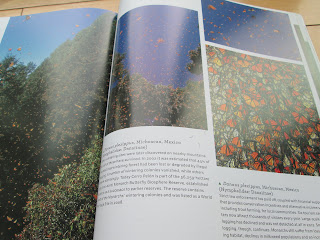Butterfly
lovers will be enchanted by this coffee table book by Ronald Orenstein and
Thomas Marent (photographer). The exquisite photography showcases the images of
butterflies from all over the world along with interesting facts about them.
The symbolism of butterflies is as rich as the
imagination of passionate artists. Different cultures attach various meanings
to them. In Japan and Mexico, for example, butterfly life cycles represent
birth, death and rebirth. Mexicans associate the arrival of Monarch butterflies
on their wintering grounds with the souls of their ancestors; it coincides with
the Day of the Dead.
Different Native American cultures view
butterflies as symbols of transformation, change, comfort and hope.
Butterflies captivate the interest of scientists,
artists and engineers. The study of these mesmerizing insects relates to
aspects of technology and design. Butterflies
offers several amazing facts about these intriguing creatures.
You will probably be surprised to learn that
Monarchs are not the only migratory butterflies. For example, whites, sulphurs
and swallowtails are accomplished long-distance migrants.
Another remarkable example are the Painted Ladies (Vanessa cardui). Their route is much longer than that of the Monarchs.
It involves a round trip from tropical Africa to the Arctic; as they cross the Mediterranean
they are propelled by the tailwinds from North Africa.
Adult
Painted butterflies live only for a few weeks, so it takes six generations to
complete the migratory cycle.
Tropical butterflies migrate too. Butterflies
from the forests of the northwest of Costa Rica migrate during the dry season
toward humid areas.
You may already be familiar with the migration
of Monarch butterflies.
Northern Monarch butterflies fly southward to
their wintering grounds in central Mexico, although a few of them stay in
Florida and Cuba. The following spring they migrate north again, but only
one-tenth of them live long enough to return to the north. Most lay their eggs
on southern milkweeds and die. Their offspring head north in less than a month.
Monarchs do not tolerate freezing
temperatures, so they are well adapted to migration. Their wings are equipped
for this purpose, and they have a structure in the brain that reacts to the
position of the sun and the patterns of polarized light in the sky. There is
also a so-called clock in the antenna that detects the sun’s position changes.
The combined information from the clock and the compass in the brain keeps the
butterflies on track toward their destination. Painted ladies, however, lack
the antennal clock.
The variety
of colorful butterflies and the incredible facts included in the book make the read fantastic; it
sparks a sense of wonder to get to know butterflies in places we may never get
to visit.
Meet the Panacea prola in Ecuador. They land on animals - humans included - to drink their sweat. They also drink from puddles, rotting wood or wet leaves.
The dazzling Dryas iulia can be found in the southern United States, Central America, the Caribbean and parts of South America (Brazil and Peru, for example). Males spend much of the day searching for females. They sip liquid and minerals from the eye secretions of caimans in Brazil and from the eyes of turtles in Peru. I had to find a photo to believe it. You can check it here:
For Monarch butterflies the presence of
milkweed is essential for the survival of their caterpillars. Without milkweed, Monarch butterflies will go extinct.
In the American Midwest, vast fields of
genetically modified herbicide - and - pesticide resistant- crops (corn, soybean
and cotton) are sprayed with chemicals that destroy milkweed and kill off
butterflies.
Butterflies are disappearing in many parts of
the world due to chemical pollution, habitat destruction and climate change.
The more we
learn, the more we can support their survival.
Avoid
spraying herbicides and pesticides in your yard; let wildflowers thrive. Plant milkweed to
support Monarch butterflies
In
Britain you can search for the United Kingdom Butterfly Monitoring Scheme and
the New Millenium Project. Do your research where you live and learn what is going on there. You may come across opportunities to cooperate with projects.
Find out what wildflowers in your area are beneficial to butterflies and plant something to support them. Whether you have a garden, a patio, a balcony or just a window sill, planting something can brighten up your space, support your mental health and attract butterflies.
Butterflies
was published by Firefly Books.
If you liked
this post, feel free to read my writing on Bicycling with Butterflies.
Bicycling with Butterflies has a special place in my heart
because it is the book that inspired me to come back to write book reviews.
Enjoy My Writing Life ride, and go plant some
flowers.





.JPG)

